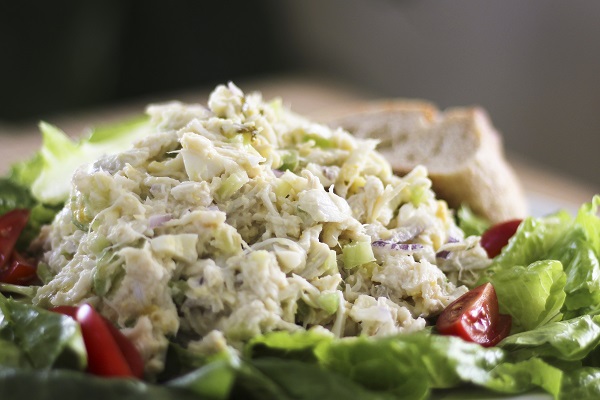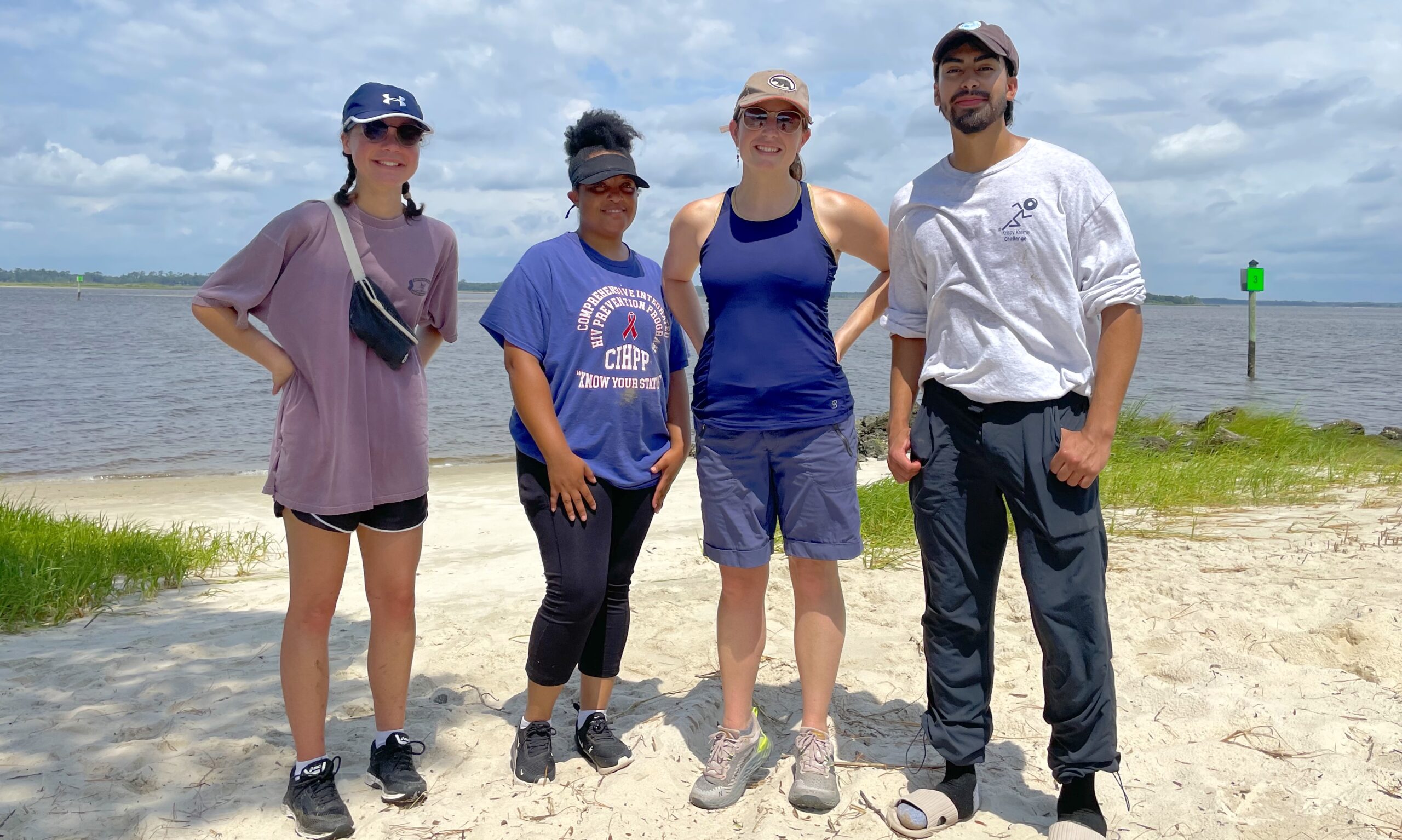How Sea Turtles Respond to Interactions with Fishermen
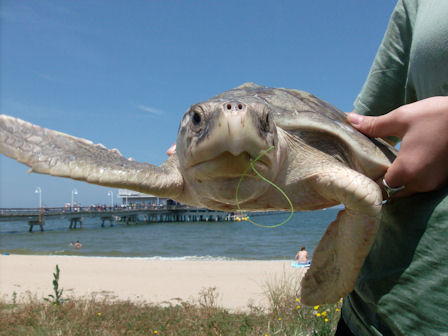
Huffing and puffing, you pause for air during a hard workout. Yet, you continue on, knowing the discomfort will end soon. Amanda Southwood Williard observes a similar fatigue following prolonged exertion, not in the gym but rather on the piers — in the blood of sea turtles.
When hooked or tangled in fishing gear, sea turtles struggle to free themselves and make it to the surface to breathe. In the absence of oxygen, lactate, a form of lactic acid, builds up in their muscles, a similar process in humans that we equate with “feeling the burn.”
Lactic acid breaks down during periods of rest, but the ocean doesn’t have a sauna or couch for reptile relaxation. As Williard, an animal physiologist at the University of North Carolina Wilmington, hypothesizes, these skirmishes make sea turtles more susceptible to boat strikes and predators while they recuperate.
“How do you feel after exercising really hard? Your ability to exercise more is compromised and the same might be true for turtles,” Williard explains. “They have these stressful experiences and need a period of rest to recover, placing them in difficult situations.”
Increased vulnerability represented just one of the threats to sea turtles that Williard and her team observed at fishing piers in North Carolina and Virginia. Their North Carolina Sea Grant-funded study laid the groundwork for assessing how recreational hook-and-line fisheries may affect sea turtles, and created an interstate collaboration interested in ensuring captured turtles return to the ocean in tip-top shape.
RIDING THE WAVES
Since the age of dinosaurs, turtles have been swimming across the oceans, expertly adapted to the marine environment. Sea turtles breathe air just like other reptiles, but can remain submerged for hours. They spend the majority of their time — Williard estimates 75 to 90 percent depending on the species — under water.
These excellent swimmers migrate between feeding and nesting areas, traveling hundreds — or even thousands — of miles regularly throughout their lives. Because of their watery ways, people know remarkably little about their behavior.
What we did know about these ancient wanderers contributed to a sharp population decline worldwide:
Many cultures prized sea turtles for their meat, eggs, oil and shells. On top of over-harvesting, humans created many other fatal threats, including marine pollution, destruction of nesting and feeding habitat, boat collisions and interactions with fishing gear — recreational and commercial alike.
Of the seven sea turtle species worldwide, six are found in U.S. waters, with five species visiting the shores of North Carolina. The green, Kemp’s ridley and loggerhead are most common here, while the leatherback and hawksbill occur infrequently. The federal Endangered Species Act, or ESA, lists all sea turtles found in U.S. waters as either threatened or endangered. Under protection of the ESA, it is illegal to intentionally or unintentionally “take” — kill, harm or even capture — any sea turtle without a permit.

For commercial and recreational fishermen up and down the coast, this is a hot-button issue as sea turtles frequently migrate through popular fishing areas. When accidentally caught in nets or on lines, the turtles cannot make it to the surface to breathe. Those that do not drown may later succumb to injuries caused by lodged hooks or entanglement in gear. Physiological changes — what Williard observes through her blood chemistry research — also may result in short- and long-term consequences for the turtles.
Matthew Godfrey, a sea turtle biologist with the North Carolina Wildlife Resources Commission, or WRC, notes that for the past few years reported strandings have increased to more than 750 a year on average in North Carolina. “This includes all turtles, from alive and injured, to dead and decomposing,” he stipulates, adding that an unusual cold snap in early 2016 led to over 2,000 strandings of hypothermic sea turtles.
Despite the close attention paid to reducing bycatch by commercial fisheries, there is no mandated reporting or monitoring of sea turtle interactions for recreational hook-and-line fishermen.
Lacking consistent reporting and regular monitoring, management agencies and wildlife professionals like Godfrey do not have a good handle on the frequency of — or damage caused by — recreational fishing encounters in North Carolina.
“Sea Grant strives to fill data gaps and this project is a wonderful example of that,” notes John Fear, deputy director of Sea Grant. “Beyond advancing our understanding of sea turtle-human interactions, Williard’s work also links together different stakeholders interested in this issue.”
HOOK, LINE AND SINKER
Originally from Lexington, Kentucky, Williard grew up around lots of horses but certainly not sea turtles. “My mom was hoping I would be an equine veterinarian,” she quips.
In college, sea turtles combined her two favorite things: herpetology and animal physiology. Her research since has revolved around how sea turtles function, specifically “their diving physiology and behavior, and how they adjust to changes in their environment,” she adds.
Williard became very familiar with Sea Grant after Martin Posey, now director of the Center for Marine Science at UNCW, suggested she apply for funds upon joining the university. She received support from the N.C. Fishery Resource Grant Program before applying for a minigrant to evaluate the blood biochemistry of sea turtles incidentally captured in recreational hook-and-line fishing.

Ciera Ames, a biology and marine biology major at UNCW, aided Williard with the latter study as part of her undergraduate honors project. Ames always had a love for amphibians and reptiles but felt a special connection to this work and to hooked sea turtles. On a family vacation to the North Carolina shore, she remembers, “I saw someone catch a turtle on the beach.”
Williard trained Ames to collect data for the study by taking her to the N.C. Aquarium at Pine Knoll Shores. They practiced handling the turtles and taking blood, which Ames proudly recalls getting on her first try. Throughout the summer of 2014, Ames, along with community volunteers, regularly monitored the pier at the Fort Fisher Air Force Recreation Area, which straddles the Atlantic Ocean and Cape Fear River, for stranded turtles.
In spite of not having consistent data for recreational interactions, “we know the Cape Fear has a lot of turtles in it from other research,” Godfrey shares. “The manager for the pier also works closely with the Pleasure Island Sea Turtle Project, and therefore, they are likely to call in hooked turtles.”
Though the observers witnessed no turtle captures on the pier, they did make valuable connections with the fishermen and the community, and posted informational signs, resulting in the later recovery of two Kemp’s ridley sea turtles for inclusion in the study.
The relatively diminutive Kemp’s ridley sea turtle, Lepidochelys kempii, lives primarily along the Atlantic coast from Mexico to Canada, preferring shallow waters where it can feed on crabs and other shellfish. They also have the unfortunate distinction of being the world’s most endangered sea turtle — and in some areas the species most commonly captured by recreational hook-and-line anglers.
With just two data points collected from 75 hours of monitoring at the pier, Williard reached out to new partners to continue the study. She already had a connection to the Virginia Aquarium & Marine Science Center, known as VAQS, in Virginia Beach. Her doctoral student Susan Barco coordinates its stranding response program.
Accurate testing requires obtaining blood samples as quickly as possible following a stranding report. “They could get there in 30 minutes,” Williard notes. Because juveniles move northward up the coast, Williard also knew the turtles most likely pass through North Carolina waters on their way to Virginia, putting individuals at risk of being captured in both states.
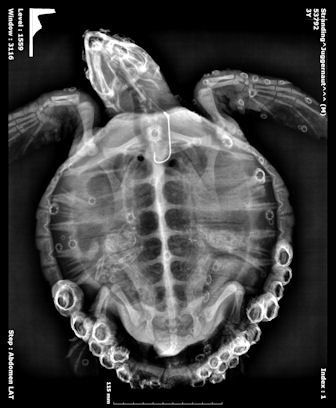
Also timely, VAQS had developed a new strategy for getting pier owners and fishermen more involved. “In the summer of 2014, we started getting regular reports of hooked turtles, but we were not very effective at recovering them,” Barco recalls. In response, they designed the Pier Partner Program, which Barco now oversees as research coordinator for the Aquarium’s Research and Conservation Division, to provide targeted resources, including a workshop, outreach materials and response kits at six piers in Virginia.
Between the two states, the research partners assessed 17 pier-captured and four rehabilitated Kemp’s ridley turtles between 2014 and 2015. The rehabilitated turtles, patients at the Karen Beasley Sea Turtle Rescue and Rehabilitation Center on Topsail Island, served as a healthy comparison to the captured turtles.
These juvenile turtles measured 23 to 48 centimeters, approximately the span from an adult’s elbow to his or her outstretched fingertips. According to Williard, most of these “cute and feisty” turtles were responsive and “ready for action” during the blood sampling and physical examination.
Results from the blood analysis found that captured turtles did experience a buildup of lactate along with other signs of metabolic disruption, but not at unrecoverable levels. “The amount of lactic acid observed we believe they could recover from. It would just place them in difficult situations,” Williard surmises.
Many of the turtles also had taken the bait: Hooks had become lodged in their esophagus or were swallowed, often requiring sedation, surgical removal and rehabilitation. Hastily pulling out the hook can cause problems, Williard warns, but “if handled properly, with all equipment carefully removed, the turtles have a good chance of surviving.”
“All fishing gear can accidentally harm protected species such as sea turtles,“ says Sara Mirabilio, North Carolina Sea Grant fisheries extension specialist. “Every day, I work with fishermen to develop or modify fishing gear and practices to minimize this bycatch and its impact. This project
starts the process of working with interested groups to provide information on local sea turtle species and what to do when a turtle is hooked from a pier.”
THE FEEDBACK LOOP
The results already have received attention from the academic community and government agencies. Ames presented her project results at the Southeast Regional Sea Turtle Symposium in 2015, winning the runner-up award in the student poster competition.
The competition allowed Ames to practice for her defense and helped her think about the big picture of her research. Meeting sea turtle “rock stars,” as she describes the influential researchers at the meeting, “made me realize the importance of what I was doing.”
Ames guesses that recreational fishermen don’t report interactions because “they are so scared they are going to get in trouble or have their license revoked. Making people more aware could really help.”
Since graduation, Ames has considered different options for playing a part in the world of biology and would consider working again with sea turtles. She views Hawaii as an ideal location, knowing that Williard also worked there. “I’ve always looked up to what she’s done.”
Williard agrees with the need for long-term outreach and education. “The best way forward is to have as much information as possible given to pier owners and fishermen so they can bring the sea turtle safely up to shore. They need to know where and to whom to report, and how to make sure a turtle is safe to release.”
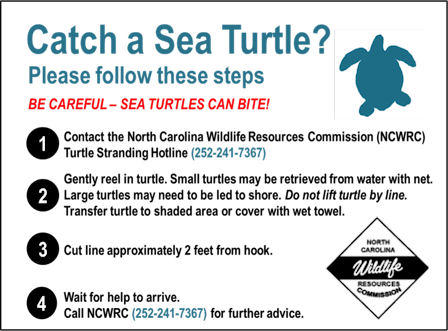
She recommends surveys as a way to proactively collect more information about interactions and the potential correlations with specific locations or types of gear. Organizations in Virginia, Mississippi and Florida have implemented similar surveys as part of larger pier outreach programs, Williard notes.
Future research and outreach efforts will require more resources, which can be a challenge but also an opportunity for more involvement by students. “There is interest from students. I am seeking additional funding to support a master’s student for this research, and to have people out on the piers during high-interaction times,” Williard clarifies.
VAQS also expressed an interest in continuing the partnership. “The exam and data collection for the stress project are very similar to our normal intake procedures for rehab patients so it was really very little extra work,” Barco points out. “It has certainly added to the data we are collecting on this problem.” Williard also reported that state and federal agencies have expressed an interest in pier outreach initiatives. Last spring, the N.C. Division of Marine Fisheries placed signs at several piers to educate fishermen about what to do in the case of a captured sea turtle. “We are hoping that having these signs up will increase the reporting of interactions when they occur,” Williard says.
Currently, the N.C. Sea Turtle Project, run by the WRC, responds to all reported cases of injured or sick turtles. “We rely on a huge network of people and groups to respond,” explains Godfrey, who helps to manage the program.
Trained volunteers and professionals check on stranded turtles reported via a statewide hotline. They help the injured ones, and bury the dead, collecting baseline data from each individual to send to the National Marine Fisheries Service for inclusion in a national database.
“This is our early-warning system,” Godfrey reckons. “It tells us more about certain threats and is helpful for figuring out ways to better manage sea turtles in the state.”
Godfrey sees this study as a good starting point for collecting the basic information needed to understand the problem and tweak the response. “The work Amanda is doing is hugely important. Having her work is going to inform how we go forward to deal with these issues,” he adds.
As any good trainer knows, it’s not whether you get knocked down, it’s whether you get back up. Williard wants to give sea turtles a fighting chance.
Report a Turtle Stranding or Capture
If you spot a sea turtle on the beach or a pier, first check to see if it has been painted — already-reported turtles are sprayed a bright color. You can report new strandings by calling the N.C. Wildlife Resources Commission, or WRC, at 252-241-7367. Note the date, time, specific location, size and condition of the turtle, and provide your name and contact information. Do not touch or move the turtle unless instructed otherwise by an official from the WRC.
This article was published in the Summer 2016 issue of Coastwatch.
For contact information and reprint requests, visit ncseagrant.ncsu.edu/coastwatch/contact/.
- Categories:
